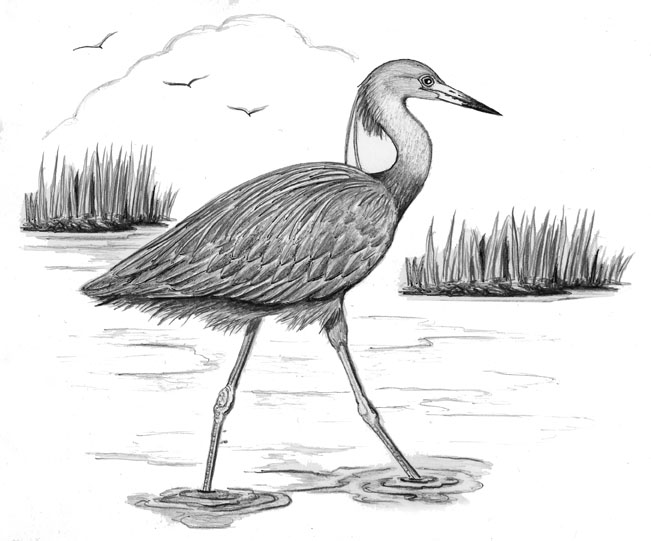
Dear Bird Folks,
I recently saw a photo of a Little Blue Heron in the Cape Cod Times. The caption said that “Little Blue Herons breed in Massachusetts, but not on Cape Cod or the islands.” Why is that?
– Sheila, Eastham, MA
P.S. Sorry for the handwritten note. I don’t have e-mail.
Here’s the deal, Sheila,
If you have a question about a story in a particular newspaper, you shouldn’t be writing to a totally different newspaper for clarification. How do I know what the Cape Cod Times is talking about? You don’t think I read that thing, do you? No way. (Psst: Okay. Between you and me, I read the CC Times every day. I just can’t let the big shots at this paper find out about it or they might cut off the free subscription they give me for writing this column. I like getting free stuff, even if it’s only a free newspaper. My first choice would be a plate of brownies, but I’ll take what I can get.)
I saw that heron story, too. It was written by noted birder Vern Laux and believe me, I’m not about to disagree with him. Not only is Vern a lot more smarterer than I am, but he’s quite a bit biggerer, too. I don’t want to do anything to get him mad. If Vern says that Little Blue Herons don’t breed on Cape Cod, so be it. Although, the Massachusetts Breeding Bird Atlas mentions that in years past, a few pairs of these birds nested at the mouth of Cotuit Bay, on a little spit of land with the lovely name of “Dead Neck Island.” I’m not sure why the herons aren’t there anymore, but my guess is the island’s sinister name was just too creepy for them.
The Little Blue Heron’s name suggests that it is a smaller version of a Great Blue Heron, but that’s not really the case. Little blues are more closely related to, and look very much like, dark editions of Snowy Egrets. In fact, for the first year of their lives, young little blues are solid white, causing them to look like Snowy Egrets. This is unique in the heron world. Researchers have theorized that the young Little Blue Herons remain white for a year so they can feed amongst the adult Snowy Egrets and gain the protection of a larger group. Makes sense to me.
Towards the end of their first year, Little Blue Herons start to grow their signature blue feathers. During the transformation the birds are a blotchy combination of white and blue, making them look like a sloppy house painter wearing well-used overalls. The adult little blues have a steel blue body, with a purplish head and neck. While this new plumage is not as showy as the bright white of the Snowy Egrets, it did help save these birds from the massive slaughter that devastated the snowy population. Plume hunters where obsessed with the white, ornate nuptial plumes of the Snowy Egrets and basically ignored the darker, less fancy little blues. Sometimes being dull and boring pays off.
The bulk of the Little Blue Heron’s breeding population is confined to the southeastern states, with scattered populations nesting along the Atlantic Coast, occasionally as far north as southern Maine. Over the past fifty years only a handful of these birds have set up breeding colonies in Massachusetts. Small colonies have been found in the town of Westport and in nearby Plymouth. Right now I’m sure you are asking, “If the birds can set up a colony in Plymouth why not on the Cape?” That is a good question, but in case you haven’t noticed the Cape is a little crowded in the summer, which is the birds’ breeding season. Little Blue Herons are a bit on the shy side. In recent years, even the most remote locations on the Cape have become accessible to people with boats, especially kayaks. There’s almost no place where the birds can go without having to deal with human interference. Over the past decade some of our more common herons – Green Herons, Black-crowned Night-herons and Snowy Egrets – have started to disappear from our area. The reason for their disappearance isn’t clear but, again, the intrusion of too many humans would be a good guess.
Another reason for our lack of little blues is that we don’t have many freshwater swamps. We have lots of saltwater marshes but the Little Blue Heron’s habitat of choice is freshwater. They like to feed along ponds and rivers and in swamps. But I think the main reason why the Cape has been void of nesting Little Blue Herons is our location. We are just too far north. The vast majority of these birds breed much further south. That’s just the way it is and we shouldn’t take it personally.
Before I go, Sheila, I’d like to mention that nearly everyone who sends me an e-mail receives an immediate reply, even if their question isn’t answered in the newspaper. However, folks like you who send old school handwritten notes don’t always hear back. Sorry about that, but it’s better that way. My handwriting is so bad that it would even stump a code breaker. Anyone attempting to read my handwriting usually ends up dizzy and cross-eyed. So it’s best to send me e-mails, but they’re your eyes and you’ve been warned.